CanePole
Dedicated to Old Fishing Tackle
Flapper Crab
Earliest Flapper Crabs were hand carved. The top four shown here are early hand carved versions. c. 1928
- 1930
Later versions were produced by Wright McGill's patented molding process. c.1930-1938, again in 1941
The fly rod
versions reflect the first style Baby Crab c. 1937, considered rare. The Red / White example is very rare.
Rare Flapper
Crab 1927 catalog insert . Front and back it provides both a great resource of information and insight into the bait and Wright
McGills approach to advertising.
Swimming Mouse
c. 1930 - 1941
Appearing around 1930 the Swimming Mouse was only available in natural or silver gray finish. Later other
colors became available. The 1941models had a metal lip.
1930 - Single casting size available, natural or silver
gray
Late 1930 - Red Head, White Body; black head, white body: white head, black body colors become available. Difficult
colors to locate in any condition.
Weedless Crawfish & Shoftshell Crawfish (Crawfish)
c.1927-32 (Weedless); Crawfish 1930-41
Wright McGill entered the metal
baits market somewhere around 1924 - 1927 introducing several small metal casting and trolling baits. Most no longer available
by 1932. Although not cataloged the Weedless Crawfish (c. 1927), bottom center, is considered one of Wright McGill's first crawfish
imitations.
The Wright McGill Shoftshell Crawfish appeared in 1930. In 1932 it was renamed to just "Crawfish" and
then in 1938/39 to Model Crawfish. Bait dating can be determined by hook attachment configuration, bait appendages and
mold detail.
Bassnabber
c. 1937 - 1942
One of the few wood baits produced by Wright McGill. The Bassnabber was first cataloged in 1938
remaining in production through 1942, however earlier designs from around 1937 have been discovered.
Sizes are about as
varied as their colors. There were thought to be only 2 sizes of the bait but other smaller versions have been found.
In this case alone there are roughly 5 varying sizes not counting the body style variances observed.


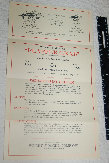
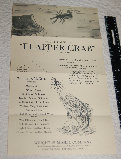


Swimming & Squatty Frog (i.e. Green Back or Frog) & Swimming Frog (Plytex)
c. 1930 - 32; Plytex 1941
The two baits, bottom
right are known as the Swimming Frog. Found from 1930 to 1932 it is believed that only two variations, one with an open mouth,
the other with a closed mouth exist. The 2 inch version shown here is the only known example and indicates there may have been
two sizes at least.
The frogs on the left side of the case are generally referenced as the Squatty frog. Its
real name varies from Green-Back Frog to just Frog. Like the Swimming Frog they vary from gapping mouth to a slightly open
mouth. The example not on the card has a metal diving lip. A 1930 magazine advertisement shows this bait, titled "Frog"
as having a metal lip. Note that this example also has glass eyes. Rare
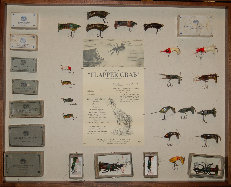
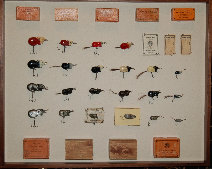


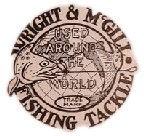
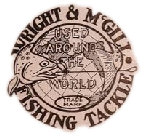
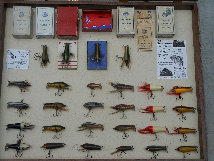
Rising Minnow, Wiggling Minnow or Bass-O-Gram
c. 1929 /30 - 1934
Recent research has shed new light on these baits. What
were generally referred to as a Wiggling Minnow or Bass-O-Gram, we have sense discovered that these baits actually started out
as Rising Minnows. See NFLCC article, "Are You Sure" Sept. 2021 for more details.
Introduced in 1929, early advertisements
indicate the bait was made of wood, but by 1932 that notation was no longer used. Made in fives sizes the primary colors were
natural and red / white. Some variations are known and are extremely rare.
The red and white fly rod or light weight spinning Wiggling
Minnow at the top measures a mere 1 1/2 inch in length.


Rising Minnow, Wiggling Minnow or Bass-O-Gram
c. 1929 /30 - 1934
The top right is actually referred to as the Midget Minnow and
is beyond rare. These examples were advertised as natural finish. We tend to call them rainbow. As with all
Wright McGill baits these reflect variations in color, gill marks and overall paint scheme. Tough to locate in any color or
size.
The bottom right bait is clearly in the Wiggling Minnow family, and gives all appearances of being a Salt Water version,
however the hardware may lean more toward a Muskie bait. Bait was located on the West coast. Measures 5.25 inches
but when measured along the contour of the bait it comes in at 6.25 inches. Only example known.

Bassnabber Prototypes
c. 1937ish
First pic reflects the variety of sizes found thus far for this line of baits. Arranged
in sequence of market introduction we think, however with Wright McGill anything is possible. The three baits shown with belly
writing were found as you see them. Experimental, it seems so. Note that center one closely mimics the final product in
size and number of hair legs. The pic of the upright bait is of the 1/4 oz bait labeled Magnolia.
The history of Wright & McGill is generally thought of in the light of trout flies and eventually Eagle Claw Hooks. However,
for a short period of time Wright & McGill produced some amazing, downright intriguing flyrod and casting baits for bass, pike,
muskie, salmon, trout and pan fish. Shown here and on subsequent pages are some of those baits that were produced
by Wright & McGill. New discoveries of Wright & McGill baits produced during this time period continue.





















